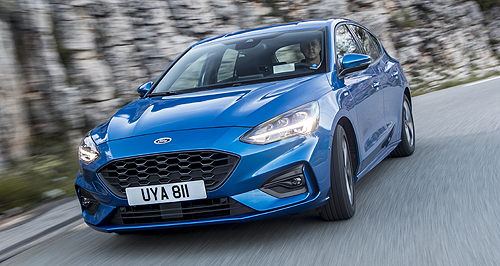Make / Model Search
News - Ford - FocusLofty Dynamic goals for new Ford FocusHigh achiever: Ford engineers were intent on ensuring the new Focus bettered the previous model in terms of dynamic prowess. Ford Focus driving dynamics manager is confident all models ‘push out the envelope’27 Jul 2018 By BYRON MATHIOUDAKIS in FRANCE FORD believes its all-new Focus is the best steering, handling and riding car of its size available anywhere in the world thanks to a “maniacal” approach to improving on the previous-generation model.
Speaking to GoAuto at the launch of the fourth-generation Focus in France last week, C2 Architecture driving dynamics manager, Guy Mathot, revealed that building on the Focus’ reputation as a leading driver’s car with a fresh set of components was a daunting challenge that consumed the best part of five years.
“We have our priorities, and at the top of these our steering has to be best in class,” he said. “So, we still have to deliver that same kind of performance still being best in class, fun to drive – for example, some drivers like lift-off tuck-in, balance and oversteer and so on – and the third point is comfort. In the past, at the third point, we had to make some trade-offs. What we wanted was no more trade-offs.
“And the way of dealing with that is making sure that some of the choices enabled us to have a bigger envelope of performance, and thus getting more performance. So, for the IRS that meant rubber-isolation bushes, the CCD adaptive dampers was one element to open up the envelope, and then there are opportunities to improve steering and handling in slalom and so-on.
Ford says the ZF-supplied electric rack and pinion steering hardware is completely new, and is now column-mounted rather than rack-mounted, which triggered a comprehensive overhaul of every hardware component as well as a complete rethink of the associated software.
Underscoring all this was a “maniacal” obsession to eliminate all forms of friction in the system, improving the feeling of connection because “we know it can ruin steering feel,” Mr Mathot said. “We know others outside of the Ford world don’t go as far as we do.”
He also deflected criticism that the cheaper torsion beam arrangement would undermine Ford’s dynamic goals compared to the IRS versions because of the years of experience gained improving the previous and current Fiesta light hatch to the point where it a class-best application.
“It’s a different technology, but one we know very well because it has been used in the B-car (Fiesta) with great success, and it’s not like we are dynamic leaders in the Focus class and then in the B-car class people see us as followers.
“And especially with the force vectoring springs, where Ford has a patent, we put really a lot of emphasis on that one, and discovered and learned on the Fiesta program that that really pays off.
“So, it’s something which we will introduce more and more in twist-beam applications in other products such as the Transit Connect with a similar axle type for exactly the same reasons.
“We think that going to that type of suspension, all of the parameters indicated is that we can live up to the expectation, and the expectation is very clearly that whatever kind of suspension is in the car – whether it is the twist beam or IRS for the five doors and the modified IRS for the wagon – we always have to have that Focus kind of character.”
Mr Mathot said he believes the difference between how Ford approaches its two suspension types compared with other manufacturers is down to Ford tuning the same consistent dynamic brand signature in both applications.
“The thing we could demonstrate with the torsion beam is brand consistency,” he said. “And that’s why we see that maybe other competition that use multiple concepts as well add different characters… obviously the envelope can be a little bit different (between torsion and IRS) but we think that envelope is bigger (in the new Focus) compared to the current model.”
Tuning the Tenneco-supplied standard dampers correctly was another work and time intensive challenge in this program, as their performance can vary so dramatically between models and variants and influence directly how the steering feels.
The optional adaptive dampers that make their debut in the Focus are the smallest application yet in a Ford, and build on the learnings obtained with their use in the Mondeo and closely related S-Max and Galaxy people-movers, as well as on several Lincoln cousin models in North America.
The optimum wheel and tyre package is 17 inches regardless of rear suspension configuration, “because it gives you the best compromise between a good steering/handling performance, comfort, rolling noises and so on,” according to Mr Mathot.
Finally, Focus development testing commenced four and a half years ago, with much of the on-road shakedown work carried out on rural Belgium roads as well as in Germany.  Read more27th of July 2018  Chinese needs drove Ford Focus design directionCommon doors on sedan, hatch eliminate iconic Ford Focus six-window profile26th of July 2018  Aussie Ford Focus designer defends ‘derivative styling’Designer admits ‘safe’ styling for Ford Focus but says daring doesn’t work26th of July 2018  First drive: Safe all-new Ford Focus soarsFord has thrown everything into its VW Golf rivalling new-generation Focus25th of July 2018  Hybrid but no full EV for Ford FocusNew Focus to go mild hybrid in 2020 as Ford keeps EV for secret new model line25th of July 2018  Ford Focus platform to spawn multiple modelsSimilar to VW’s MQB set-up, Ford Focus platform will underpin passenger cars, SUVs24th of July 2018  Why most Ford Focus models ditch IRSOnly reputation kept torsion beam from taking over completely in new Ford Focus |
Click to shareFord articlesResearch Ford Focus pricing
Motor industry news |











Facebook Twitter Instagram